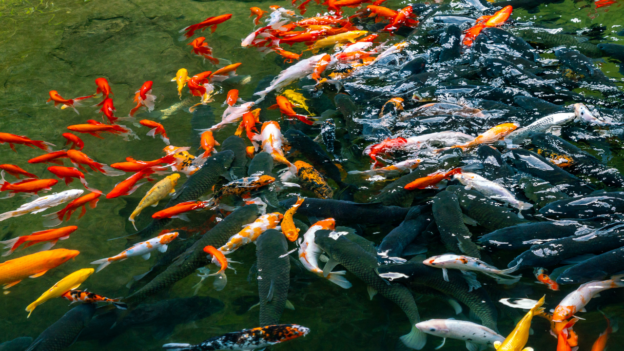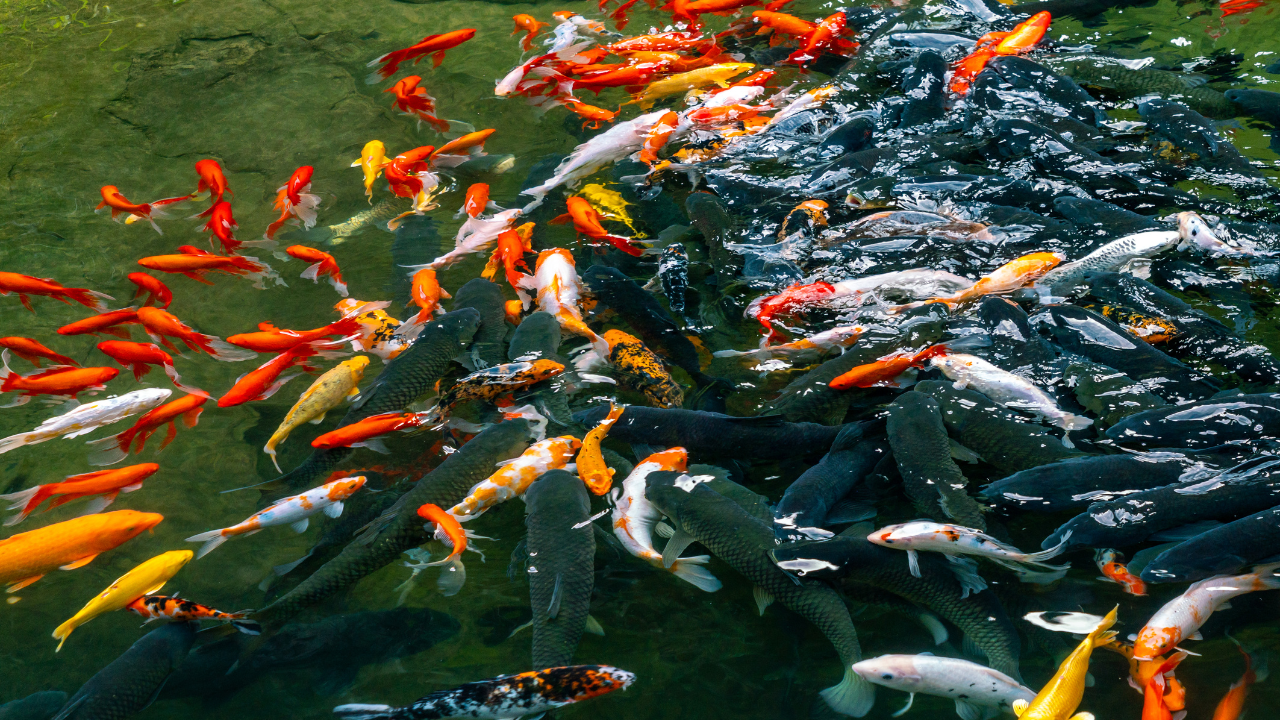Key Takeaways:
- A balanced pond ecosystem is essential for a thriving aquatic environment.
- Aquatic plants, fish, beneficial bacteria, and water quality are key components.
- Choose the right plants and maintain a balanced fish population.
- Incorporate beneficial bacteria and monitor water quality regularly.
- Ensure proper aeration and filtration for a healthy pond ecosystem.
A balanced pond ecosystem is the key to maintaining a beautiful, healthy pond that thrives year-round. When a pond is in balance, it supports a harmonious relationship between fish, plants, microorganisms, and water quality, creating a self-sustaining environment. But, achieving this balance requires regular maintenance and the right approach to pond care.
A healthy pond ecosystem depends on many factors, some important ones are:
- Aquatic Plants
- Balanced Aquatic Life
- Bacteria
- Water Quality
In this article, we’ll explore the steps you can take to create a balanced pond ecosystem. From choosing the right plants and fish to managing water quality and incorporating beneficial bacteria. Whether you are looking for advice on pond and fountain repair in Orange County or need pond fountain parts and supplies in Orange County. These tips will help you keep your pond in perfect harmony.
Understanding Your Pond Ecosystem
A pond ecosystem consists of various components that interact with each other to maintain balance. These components include:
- Aquatic Plants: Plants like water lilies, reeds, and submerged plants provide oxygen. Offer shelter, and help absorb excess nutrients, preventing algae growth.
- Fish and Other Aquatic Life: Fish add life to your pond, but they also produce waste, which can affect water quality. Balancing fish populations is crucial to maintaining a healthy ecosystem.
- Beneficial Bacteria: These microscopic organisms play a vital role in breaking down organic waste. Such as fish waste and decaying plant matter. They help keep water clean and free of harmful toxins.
- Water Quality: Clear, oxygen-rich water is essential for a balanced pond. Factors like pH, ammonia, nitrate levels, and oxygen levels must be regularly monitored. To ensure optimal conditions for aquatic life.
Understanding these components is the first step to achieving a balanced pond ecosystem. Let’s explore some practical tips for maintaining this balance.
1. Choose the Right Aquatic Plants
Aquatic plants are the cornerstone of any balanced pond ecosystem. They provide oxygen, absorb excess nutrients, and offer shelter and breeding grounds for fish and other aquatic life. When choosing plants for your pond, consider incorporating a mix of submerged, marginal, and floating plants:
- Submerged Plants: These plants, such as anacharis and hornwort, grow entirely underwater and are excellent oxygenators. They help keep the water clear by absorbing nutrients that would otherwise fuel algae growth.
- Marginal Plants: Plants like cattails, irises, and pickerelweed grow along the pond’s edges, providing habitat and shelter for various species. They also help stabilize the pond’s banks and prevent erosion.
- Floating Plants: Water lilies, water hyacinths, and duckweed float on the surface. Providing shade that limits sunlight penetration and reduces algae growth. Floating plants also offer cover for fish, protecting them from predators.
Balancing the different types of plants ensures that your pond has enough natural filtration, oxygen, and habitat diversity. Contributing to a healthier ecosystem. If you need help selecting or installing plants, consider reaching out to professionals. Specializing in pond and fountain repair in Orange County.
2. Maintain a Balanced Fish Population
Fish add life and beauty to your pond, but it’s crucial to maintain the right balance to prevent overpopulation and waste build-up. Here are some tips for managing your fish population:
- Stock Wisely: A general rule of thumb is to have no more than 1 inch of fish per square foot of pond surface. Overcrowding can lead to poor water quality. As more fish produce more waste. Which can deplete oxygen levels and increase the nutrient load.
- Feed Appropriately: Overfeeding fish is a common mistake that can upset the pond’s balance. Uneaten food decays and contributes to nutrient build-up, leading to algae blooms. Feed your fish only what they can consume in 2-3 minutes, once or twice a day.
- Choose Compatible Species: Different fish species have different needs and behaviors. Choose fish that are compatible in size, temperament, and water conditions. Popular choices like koi and goldfish are generally compatible, but ensure they are not overcrowded.
If you’re unsure about managing fish populations or suspect an issue. Consulting a professional for pond and fountain repair in Orange County can provide valuable guidance.
3. Incorporate Beneficial Bacteria
Beneficial bacteria play a crucial role in maintaining a balanced pond ecosystem. These bacteria break down harmful substances. Like ammonia and nitrites produced by fish waste and decaying matter, converting them into less harmful nitrates.
- Add Bacterial Supplements: Adding a beneficial bacteria supplement to your pond can help boost natural filtration, especially in new ponds or after significant cleaning. Look for quality products available at stores specializing in pond fountain parts and supplies in Orange County.
- Promote Natural Bacteria Growth: Create an environment that supports beneficial bacteria. By ensuring good water circulation and oxygen levels. This involves using a high-quality filtration system. Maintaining proper aeration through pond fountains or aerators.
Regularly incorporating beneficial bacteria not only helps maintain water clarity. But also supports a balanced ecosystem, reducing the need for chemical treatments.
4. Monitor and Improve Water Quality
Water quality is a critical aspect of pond care. Regular monitoring and maintenance can prevent issues before they become problematic:
- Test Water Regularly: Use a water test kit to check key parameters like pH, ammonia, nitrites, nitrates, and oxygen levels. Keeping these levels in check is essential for maintaining a healthy pond environment.
- Perform Regular Water Changes: Change 10-20% of your pond water every two weeks. To dilute toxins, reduce excess nutrients, and improve water clarity. Make sure to use a water conditioner to neutralize chlorine if using tap water.
- Control Algae Growth: Algae can quickly disrupt the balance of your pond. Use natural algae controls like barley straw, UV clarifiers, or algae-eating fish to prevent excessive growth. Avoid chemical treatments unless necessary, as they can harm fish and beneficial bacteria.
For expert advice on managing water quality or help with pond maintenance. Consider seeking professional services for pond and fountain repair in Orange County.
5. Maintain Proper Aeration and Filtration
Aeration and filtration are vital to maintaining a balanced pond ecosystem. Proper aeration ensures adequate oxygen levels, while filtration removes debris and harmful substances.
- Install a Quality Filtration System: A good filtration system should include both mechanical and biological components. Mechanical filters remove debris. While biological filters promote beneficial bacteria growth that breaks down waste.
- Use Aeration Devices: Aeration devices like pond fountains or air pumps increase oxygen levels. Promoting a healthier environment for fish and plants. Investing in reliable pond fountain parts and supplies in Orange County can ensure your aeration devices work efficiently.
By maintaining proper aeration and filtration, you create a stable environment. Where aquatic life can thrive, contributing to a balanced pond ecosystem.
Ready To Have a Balanced Pond Ecosystem?
Achieving and maintaining a balanced pond ecosystem is essential for creating a thriving, beautiful, and self-sustaining pond. By carefully selecting the right aquatic plants, and managing fish populations. Incorporating beneficial bacteria, monitoring water quality, and ensuring proper aeration and filtration. You can promote a harmonious environment where all elements work together.
Good pond care is not just about aesthetics. It’s about fostering an environment that supports life and brings tranquility to your outdoor space. If you need help with maintenance or repairs. Contact Orange County Pond Fountain Service today to ensure your pond remains in top condition.

